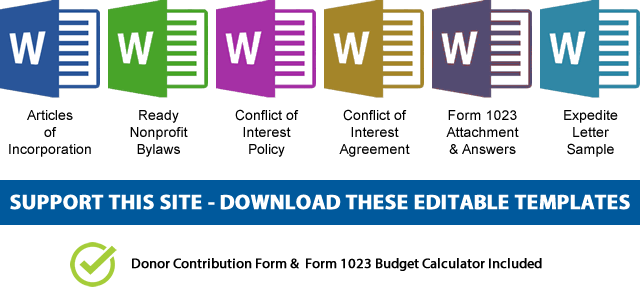Record keeping for nonprofits, penalties and loss of tax-exemption status
A nonprofit 501c3 organization must keep books and records to show it complies with IRS tax rules, and it must be able to document the sources of receipts and expenditures reported on Form 990. If an organization does not keep required records, it may be unable to show it qualifies for exemption. Thus, the organization may lose its tax-exempt status. In addition, an organization may be unable to complete its tax returns accurately and may be subject to penalties. Record keeping and document retention policy should be included in the nonprofit bylaws of all 501c3 tax-exempt organizations.
Monitor Programs
An effective record keeping system enables an organization to monitor the progress of programs and aid in the preparation of financial statements and returns. Records can show whether programs are improving, which programs are successful, and what changes an organization may need to make. Good records management can contribute to the success of a program and an organization.
Prepare Financial Statements
It is important for organizations to maintain revenue and expense statements and balance sheets to prepare accurate financial statements. These statements can help an organization when working with banks, creditors, contributors, and funding organizations.
Prepare Annual Returns and Tax Returns
Records must support income, expenses, and credits as reported on the Form 990 series of federal returns and on state tax returns. These can often be the same records used to monitor programs and prepare financial statements.
Also, books and records of exempt organizations must be available for inspection by the IRS. If the IRS examines an organization’s returns, the organization may be asked to explain items reported. A complete set of records will speed up the examination.
Substantiation of Taxable Revenue and Expenses
Another reason for good record keeping is to substantiate revenues, expenses, and deductions for Unrelated Business Income Tax purposes. A 501c3 nonprofit organization must appropriately track the revenues and expenses subject to UBIT so that it can prepare its UBIT return on Form 990-T, Exempt Organization Income Tax Return.
Comply with Grant-Making Procedures
A charity that makes grants to individuals must keep adequate records to demonstrate that such grants serve charitable purposes. At a minimum, the records should show names and addresses of grantees, purpose of the grant, manner of selecting the grantees, and relationship of the grantees to any members, officers, trustees, or donors of the organization.
Comply with Racial Non-discrimination Requirements (Private Schools)
Private schools must keep records showing they have complied with requirements relating to racial nondiscrimination, including annual publication of a racially nondiscriminatory policy through newspaper or broadcast media to the community served by the school. For more information, see Schedule E, Schools, on the Form 990 and its accompanying instructions.
What Records 501c3 nonprofits Should keep?
Except in a few cases, the law does not specify record keeping processes. A nonprofit corporation should keep records of board of directors’ meetings. Tax-exempt organizations can choose any record keeping system, suited to its activities, that shows its income and expenses. If an organization has more than one program, it should ensure records identify the income and expense items attributable to each program.
A record keeping system must include a summary of transactions. This is ordinarily written in the organization’s books, such as accounting journals and ledgers. The books must show, among other things, gross receipts, purchases, other expenses, employment taxes, and assets. For many small organizations, a checkbook may be the main source for entries in the books, while larger organizations need more sophisticated ledgers and records. All organizations must keep all documentation that supports the entries in the books.
Accounting Periods and Methods
Organizations must keep their financial records based on an annual accounting period called a tax year.
Accounting Periods: A tax year is usually 12 consecutive months. There are two kinds of tax years:
- Calendar tax year: This is a period of 12 consecutive months beginning January 1 and ending December
- Fiscal tax year: This is a period of 12 consecutive months ending on the last day of any month except
Accounting Methods: An accounting method is a set of rules used to determine when and how income and expenses are reported. An organization chooses an accounting method when it files its first annual return. There are two basic accounting methods:
- Cash method: Under the cash method, an organization reports income in the tax year It usually deducts expenses in the year paid.
- Accrual method: Under an accrual method, an organization generally records income in the tax year earned, even though it may receive payment in a later year. It records expenses in the tax year incurred, whether or not it pays the expenses that
Supporting Documents
Transactions such as contributions, purchases, sales, and payroll will generate supporting documents (e.g., grant applications and awards, sales slips, paid bills, invoices, receipts, deposit slips, and canceled checks) that contain information to be recorded in accounting records. It is important to keep these documents because they support the entries in an organization’s books and on its tax and information returns. They should be marked and stored in a safe location.
Records Management
Gross Receipts: Gross receipts are the amounts received from all sources, including contributions. An organization should keep supporting documents that show the amounts and sources of its gross receipts. Documents that show gross receipts include cash register tapes, bank deposit slips, receipt books, invoices, and credit card charge slips.
Purchases, Including Accounting For Inventory: Purchases are items bought, including any items resold to customers. If an organization produces items, it must account for any items resold to customers. It must also account for the cost of all raw materials or parts purchased for manufacturing into finished products. Supporting documents should show the amount paid and verify the payment was for purchases. Documents for purchases include canceled checks, cash register receipts, credit card sales slips, and invoices. These records will help an organization determine the value of its inventory at the end of the year. See Publication 538, Accounting Periods and Methods, for general information on methods for valuing inventory.
Expenses: Expenses are the costs incurred by an organization to carry on its programs. Supporting documents should show the amount paid and the purpose of the expense. Documents for expenses include canceled checks, cash register tapes, contracts, account statements, credit card sales slips, invoices, and petty cash slips for small cash payments.
Employment Taxes: Organizations with employees must keep records of compensation and specific employment tax records. See Publication 15, (Circular E), Employer’s Tax Guide, for details.
Records of Assets and Liabilities of a nonprofit 501c3
An organization must keep records to verify information about its assets and liabilities. Assets are the property an organization owns and uses in conducting its activities, such as investments, buildings, and furniture, and liabilities reflect the financial obligations of the organization. Records should show:
- When and how the asset was acquired
- Documents that support mortgages, notes, loans, or other forms of debt
- Purchase price
- Cost of improvements
- Deductions taken for depreciation
- Deductions taken for casualty losses, such as losses resulting from fires or storms
- How the asset was used
- When and how the asset was disposed of
- Selling price
- Expenses of the sale
Typical Documents
Documents that show the above information include purchase and sales invoices, real estate closing statements, canceled checks, and financing documents. If an organization does not have canceled checks, it may be able to get payment information from account statements prepared by financial institutions. These include account statements prepared for the financial institution by a third party. Account statements must be legible. The following list shows the contents of acceptable account statements.
- Check: Check number, amount, payee’s name, and date the check amount was posted to the account by the financial institution.
- Electronic funds transfer: Amount transferred, payee’s name, and date the transfer was posted to the account by the financial institution
- Credit card: Amount charged, payee’s name, and transaction date
How Long To Keep Records For nonprofit Tax Purposes?
For federal tax purposes, an exempt organization must keep records that support an item of income or deduction on a return until the statute of limitations for that return runs.
The statute of limitations has run when the organization can no longer amend its return and the IRS can no longer assess additional tax. The statute of limitations generally runs three years after the date the return is due or filed, whichever is later. An organization may be required to retain records longer for other legal purposes, such as for state or local tax purposes.
Additional Record Retention Periods
Other record retention periods vary depending on the type of record or return.
Permanent Records: Some records should be kept permanently. These include the application for recognition of tax-exempt status, the determination letter recognizing tax-exempt status, organizing documents (such as articles of incorporation and by-laws, with amendments), and board minutes.
Employment Tax Records: If an organization has employees, it must keep employment tax records for at least 4 years after the date the tax becomes due or is paid, whichever is later.
Records for Non-Tax Purposes: An organization should keep records until they are no longer needed for non-tax purposes. For example, a grantor, insurance company, creditor, or state agency may require that records be kept longer than the IRS requires.
 NOTE: If you’d like to receive the following organizing documents:
NOTE: If you’d like to receive the following organizing documents:- Nonprofit Articles of Incorporation,
- Nonprofit Bylaws,
- Nonprofit Conflict of Interest Policy,
- Conflict of Interest Policy Acknowledgment,
- Form 1023 Attachment with all the answers,
- Form 1023 Expedite Letter template,
- and Donor Contribution Form
in Microsoft Word Document format, please consider making a donation and you’ll get to download them immediately. Not only they're worth well over $1000 in value, they will save you weeks of copy pasting and formatting as they are ready to go templates which only need changing names and addresses.

